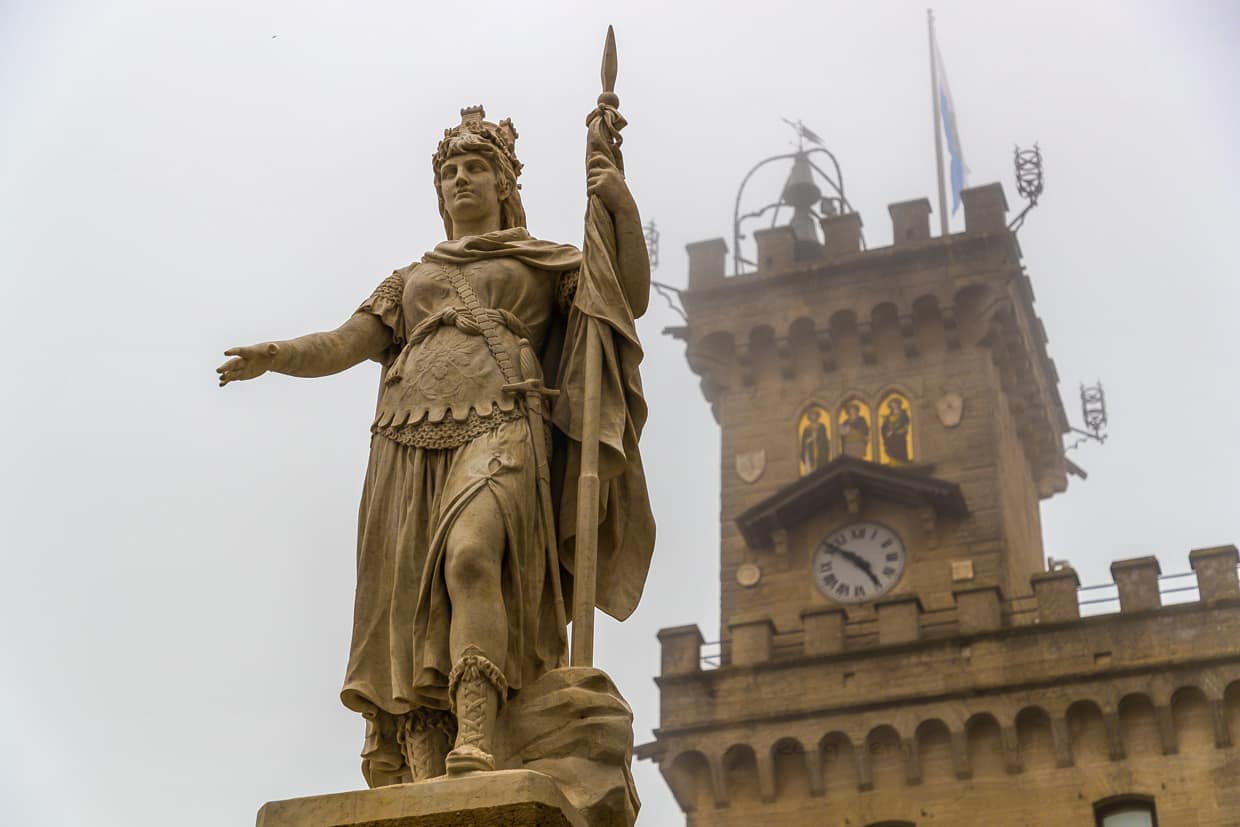The dual leadership, we know it as a classic formation in soccer, when two strikers share the offensive load. The political counterpart is the San Marino model of government. It shares responsibility, uses synergies, but requires perfect teamwork. In San Marino, the strikers are called Capitani Regenti. Their tradition dates back to the 13th century. They made their first documented appearance as Consules on December 12, 1243. This makes San Marino the oldest active republic in the world. This dual leadership guarantees political stability and a balance of power. In 1981, Maria Lea Pedini was the first woman to be elected Capitana Reggente. The swearing-in ceremony takes place twice a year. A visit to the Palazzo Pubblico with Silvia Berti, Director of Diplomatic Protocol, and Giovanna Crescentini, Secretary of State for Home Affairs.

Lived democracy
Every year, shortly before April 1 and October 1, preparations for the ceremonial swearing-in of the new state representatives are in full swing. Silvia Berti, the head of protocol, masters the process down to the smallest detail. While the top leadership of the Republic of San Marino changes every six months, Berti has served the state for almost 30 years. She has appointed numerous Capitani Reggenti to office. “Our model of government requires a lot of cooperation – the Capitani Reggenti first have to learn that there are two of them,” explains Berti. Both office holders have a mutual right of veto, which prevents a concentration of power. The collective leadership approach with a six-monthly rotation invigorates politics and prevents entrenched power structures.

Tradition and diplomacy
On the day of the inauguration, parades parade through the old town. Everything takes place between the Palazzo Pubblico on the Piazza della Libertà and the Basilica of St. Marinus. The ceremony is also a public festival and tourists are welcome, emphasizes Silvia Berti. However, given the high frequency of swearing-in ceremonies, not all San Marinese are on their feet, she admits. Only 33,500 people are allowed to call themselves San Marinesi – the equivalent of the population of a medium-sized European city. But despite its small size, the Republic of San Marino maintains an impressively active diplomatic network. It maintains relations at several levels: with the United Nations, the OSCE, the Council of Europe and the International Monetary Fund. San Marino also maintains 11 embassies and diplomatic contacts with over 110 countries. Silvia Berti reports that maintaining these relationships is also one of her tasks. She herself has already been ambassador to Finland, Estonia and Lithuania.

Rotating power in the Palazzo Pubblico
It is session week in the parliament of San Marino. The 60 members of parliament work on a voluntary basis and mostly have other professions. San Marino’s parliament meets irregularly, as required, and thus remains flexible – typical of small states with direct governance. The two Capitani Reggenti chair the Consiglio Grande e Generale (parliament), but do not have the right to vote. They chair the sessions and, as the supreme guarantors of state order, ensure compliance with constitutional principles.

Giovanna Crescentini leads us onto the balcony of the conference room. The lawyer is responsible for internal administration, public safety and institutional coordination. She also supports the Capitani Reggenti in protocol and administrative matters. The Capitani Reggenti are elected from among the deputies, explains Crescentini. Francesca Civerchia, the current Capitano, demonstrates the changing responsibilities of parliamentarians: the social scientist has been a member of parliament since 2019. As a member of parliament, she initiated a law to support single mothers, explains Crescentini. As head of government, she is not allowed to initiate new laws, but only to announce them publicly.

Long live democracy!
The Capitani Reggenti in San Marino are among the oldest continuously existing democratic offices in the world. Their origins date back to the 13th century. Early on, the term of office was set at six months and a mutual right of veto was introduced to prevent tyranny. The statutes of 1600 specified these rules and today, 425 years later, act as a handbook for a resilient democracy: at that time, the minimum age was set at 25 years, direct re-election was prohibited by a three-year break and accountability was demanded at the end of the term of office.

Two times a year, citizens can introduce legislative initiatives according to the Arengo tradition – a rare model of direct democracy in Europe. The model of government has remained in place since 1243, even during the unification of the fragmented Italian states in the 19th century and during fascism. In 2008, UNESCO recognized it as a World Heritage Site as it represents a unique model of medieval democracy.

What the world can learn from San Marino
While many democracies suffer from populism or authoritarianism, San Marino proves how historical institutions, citizen participation and separation of powers promote stability. Even microstates can be global role models. San Marino’s foreign policy focuses on human rights, peacekeeping and economic cooperation. The state has shown greatness on several occasions, particularly in refugee issues. In 1943 and 1944, San Marino offered protection to civilians and persecuted people: Jews, political opponents of the Mussolini regime and war displaced persons.

Despite fascist rule, the country saved some Jews from deportation. During the war years, San Marino took in 100,000 people. Ten times its population. The accommodation was inventive: a disused railroad line between San Marino and Rimini served as mass accommodation, schools, monasteries and parish halls became refugee camps, and private individuals opened their doors. Silvia Berti emphasizes that peace, democracy and freedom are the cornerstones of her country. After the Russian attack on Ukraine, San Marino acted immediately: it took in Ukrainian refugees, integrated children into schools and sent electricity generators as donations in kind.

Why Napoleon was rebuffed
San Marino’s rulers proved their skill in dealing with great powers on several occasions. For example, they turned down a generous gift from Napoleon Bonaparte, an ardent admirer of their republic. During his Italian campaign in 1797, he offered San Marino an extension as far as the Adriatic, as well as cannons and grain. He ordered his army to respect the borders of the small state. The San Marines refused the land in order to avoid conflict with their neighbors and only accepted the grain as a symbolic gesture. They maintained their neutrality and placed sovereignty above expansion.

Saint Agatha and tracks in the snow
The Republic of San Marino owes its continued existence not only to diplomatic skill but also, it is said, to divine assistance. Alongside the founding saint Marinus, Saint Agatha is considered the co-patron saint of the city-state. Her veneration is linked to a legend that tells of the defense of San Marino: In the 6th century, Agatha is said to have led an enemy army astray with a sudden snowfall, thus preventing an attack. This legend probably reflects real threats when local rulers and ecclesiastical authorities questioned the independence of the small community. Because of this miraculous rescue, Agatha was elevated to the second patron saint of San Marino in the Middle Ages. And because history often returns in strange ways, here’s a thought: perhaps Greenland will soon need divine assistance. Saint Agatha knows all about snow. Who knows if she won’t have to perform another miracle when democracies start to falter.

More about San Marino
The dual leadership of San Marino is about the Capitani Regenti, one of the oldest democratic offices in the world. More recent attractions in San Marino include well-developed hiking trails. The Sentiero della Rupe circular trail leads past the three towers of the Republic and then turns into a cliff path that runs along the steep, rocky flank of Monte Titano. Whether you simply stroll through the narrow streets of the old town and enjoy the view again and again or take an extended hike, for example to Eduardo Kobra’s remote mural “The History of San Marino”: In the evening, restaurants such as Cesare, La Terrazza or Il Ghetto da Ottavio reward you with culinary specialties. A snack for in between is already set with piadina!
The research was supported by Visit San Marino


